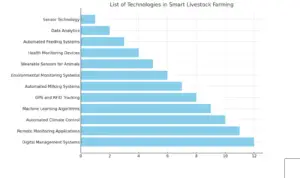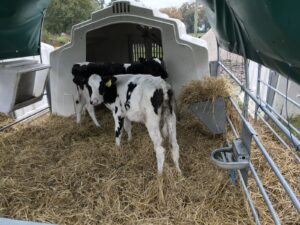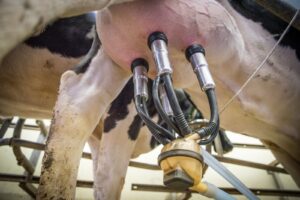The farming industry faces increasing scrutiny over its practices, particularly concerning animal welfare. The alignment of industry practices with public perception towards animal treatment has become critical.
A lack of knowledge on how to handle cattle can profoundly impact both farm workers and animal welfare. Poor handling practices can induce stress and fear in cows, leading to increased disease susceptibility, decreased production, and behaviours that increase the risk of injuries to both cattle and keepers.
Injuries from cattle are among the most common causes of severe accidents in the agricultural sector, and the public perception of cattle handling has become increasingly relevant, with negative media portrayals of poor handling practices significantly impacting opinions about the industry.
Why is Cattle Handling Necessary?
Working with livestock is a complex job; it requires passion and careful consideration in many aspects. One of the critical aspects to consider when keeping cattle is that there will be many instances where it will be necessary to handle them.
- Veterinary treatments
- Routine health checks
- Management tasks like tagging
- Moving cattle from one location to another

Cattle handling is important for Veterinary treatments – Photo Renzo Di Florio
What is the Instinctive Behaviour of Cattle?
Cattle have innate behaviours and instincts that influence how they react to their surrounding environment.
Cattle are herd animals by nature, and their behaviour is primarily driven by instincts to protect themselves from predators and to seek comfort in the herd. They have a solid following instinct, preferring to move in groups rather than individually. Cattle are also creatures of habit and respond best to routine and familiar environments and people.
Their vision is another critical aspect of their behaviour. Cattle have a wide field of vision, with a nearly 360-degree view, allowing them to see from all angles. However, they have poor depth perception and can be easily frightened by sudden movements.
Depending on different cattle breeds, how they have been raised, daily routine, and previous experiences, some cows may be more docile and friendly than others, and some will show a timid and sceptical approach to handling, the surrounding environment and people.
Fun and less fun facts I have learned with my experience working as a Farm Veterinarian:
- Dairy cows, due to their management daily routine, are incredibly docile, to the point that on some occasions, they can be around you licking and sniffing you without a break (that made my life difficult at times when I was visiting another, maybe sick, cow or calf)
- Dairy-breed bulls (Holstein or Frisian, and even more Jersey bulls) require very high attention when handled. They can be very unpredictable, and their high testosterone levels can make them aggressive. The difficulty in handling bulls for routine or Veterinary tasks is one of the reasons many farms are moving away from stock bulls and using Artificial Insemination instead.

Limousine beef cows are timid and with a nervous temperament – Photo Renzo Di Florio
- Beef cows are usually very timid; management practices and genetic traits make these cattle more prone to stress and erratic behaviours. They must be handled carefully to avoid injury to cattle and people. In my experience, a special mention goes to breeds like Limousines, Charolais, and Bazadaize cattle – all breeds originated in France. Or breeds of Italian origin like Piementose or Chianina. On the other hand, British breeds like Herefords, South Devons or Highland Cows are significantly more docile and composed.

Longhorn beef cows are very docile – Photo Renzo Di Florio
- Due to high hormonal levels and protective instincts towards their newborn calves, freshly calved cows must always be approached cautiously and only if necessary.
- Young female and male cattle express all these characteristics at a higher level. Age helps older cows and bulls become calmer and more accustomed to handling, the presence of people and the changes in the surrounding environment.
- Cattle that spend most of their time grazing will be less accustomed to handling.
Cattle “Flight Zone” and “Point of Balance”
One of the well-known concepts in animal behaviour is that they have a freeze, flight, and fight response included in their instinct.
In particular, several studies, especially from Temple Grandin, have shown the concept of the ‘flight zone’ in cattle handling.
The flight zone is the animal’s individual space; its size varies depending on the cattle’s tameness and previous experiences with humans. The cattle move away when a handler enters this zone around the animal. The size of this zone can indicate the animal’s fear or calmness; usually, tame cattle have a tiny flight zone.
The’ point of balance’ is closely related to the flight zone, typically present at the animal’s shoulder level. By positioning themselves relative to this point, handlers can influence the direction in which cattle move. If the handler stands in front of the point of balance, cattle will tend to move backwards, while standing behind this point generally causes the cattle to move forward.
These two concepts are essential when moving cattle.
How do you Know if a Cow is Agitated?
Recognizing the signs of agitation and stress in cattle is vital for preventing accidents, ensuring animal welfare, and protecting handlers.
The signs of nervousness and stress in cattle can differ depending on the situation and circumstances.
In my experience, approaching cows with a newborn calf, a bull, or cattle scared by a traumatic event has always been the riskiest situation for the animals and myself.
The signs I was usually looking for while approaching these animals were:
- Ears positioning and staring
- Tail flicking
- Stomping or rasping in the ground
- shaking their heads
- Displaying a rigid posture
However, even animals not showing such behaviours may present a safety risk.
Stressed cattle are more unpredictable and potentially dangerous, making it essential for handlers to be able to identify and address these signs quickly.
Reducing stress in cattle improves their well-being and makes handling them much safer and more efficient.
What is a Cattle Handling System?

Cattle handling systems – Photo Renzo Di Florio
A cattle handling system is a set of facilities and practices designed to manage and handle cattle.
The system is designed to accommodate the natural behaviour and movement of cattle. It comprises a series of interconnected pens, alleys, and chutes that guide the cattle through various handling processes. The layout is typically designed to minimize stress and injury to the animals and people and to facilitate ease of movement.
Handling Facilities for Cattle
- Chutes or Race: Narrow passages where cattle are guided. They are typically equipped with robust and plain lateral panels. Cattle tend to be distracted if they can see through the lateral panels. Design the layout – cattle prefer moving circularly, so having a curved race can help. Funny tip: Studies have shown that cattle like to move anticlockwise.
- Crushes or Squeeze Chutes: Specialized chutes equipped with mechanisms to restrain cattle, usually fitted with a yoke or squeezing lateral panel. It is essential to choose the crush according to the temperament of the animals and the main reasons why the crush will be used.

Cattle Crush with head yoke – Photo Renzo Di Florio
- Corrals and Holding Pens: Enclosed areas where cattle are temporarily held.
- Sorting Pens: Used to separate cattle into different groups based on criteria like age, sex, or health status.
Safety Features For Cattle Handling Facilities
- Non-Slip Surfaces: Cattle are more likely to panic and become uncontrollable on slippery surfaces. Non-slip flooring in handling areas, such as grooved concrete or rubber mats, can significantly reduce the risk of falls and injuries.
- Adequate Space: The facility should provide enough space for cattle to move freely without overcrowding. Chutes and alleys should be designed to match the size of the cattle being handled, allowing them to move smoothly without excessive restraint.
- Solid Fencing and Gates: Sturdy and well-maintained fencing and gates are crucial to contain and direct cattle safely. Visibility is also essential; solid lateral panels on the side of the chutes are better than bars; it keep cows calmer, and it was not uncommon in my experience that cows put a leg through the barrier with a real risk of injury.
- Calm Handling Area: The area should be designed to minimize noise and distractions, as these can stress cattle. Rounded corners and curved chutes can be beneficial, as they align with cattle’s natural tendency to circle and follow a curved path.
- Access Points for Handlers: Safe and strategic access points are necessary for handlers to enter and exit the handling areas quickly and safely.
Methods to Reduce Stress in Cattle During Handling
Reducing stress in cattle during handling is not only humane but also enhances the safety and efficiency of the process.
- Gentle Handling: Using calm, gentle handling techniques can significantly reduce stress. These techniques include avoiding loud noises, sudden movements, and rough handling. Always maintain a peaceful and careful demeanour.
- Understanding and Utilizing Cattle Behavior: Handlers should leverage their understanding of cattle behaviour, such as the flight zone and point of balance, to guide cattle more effectively and with less stress.
- Environmental Modifications: Using solid barriers to limit visual stimuli and designing handling facilities to encourage natural cattle movement can help minimize stresses. These facilities should be free of hazards that could injure cattle or handlers, such as sharp edges, loose boards, or slippery surfaces.
- Consistent Routines: Cattle are creatures of habit and respond well to consistent routines. Maintaining a regular handling schedule can help reduce anxiety and stress.
- Training and Conditioning: Conditioning cattle to handling procedures through regular, positive interactions can desensitize them to human contact and handling facilities, thereby reducing stress during more intensive handling activities.
- Do not use sticks, hit animals or twist tails: Gentle encouragement is more than enough. If necessary, a paddle equipped with a rattle may be used. It only makes a rattle sound and is easy to see and hear for cattle.
Approaching and Moving Cattle Safely
When approaching cattle, it is essential to do so calmly; quick movements or loud noises can startle the animals, increasing the risk of injury. Handlers should approach cattle from the side, where they are easily visible, rather than directly from behind or front, which can threaten the animals.
As discussed earlier, understanding the cattle’s flight zone and balance point is crucial in moving them effectively. Handlers should work at the edge of the flight zone to encourage movement without causing panic or stress. Moving steadily and predictably helps maintain control and keeps the cattle calm.
Techniques for Herding and Moving Cattle in Groups
Herding cattle in groups requires coordination and an understanding of herd dynamics. Moving cattle in a group is often more straightforward, as they naturally follow each other.
Handlers should position themselves strategically, using the principles of the flight zone and point of balance to direct the group’s movement. Moving alongside the cattle, gently guiding them in the desired direction is often practical. Multiple handlers may be required in larger spaces, positioned at different points around the group to guide and direct them.
Handling Individual Cattle
Handling individual cattle, especially for health checks or treatments, requires a more focused approach.
It is essential to isolate the individual animal safely and securely using a chute or a small pen.
Using force can create a negative reinforcement for cattle that do not like handling. On the other hand, using food treats helps cattle connect to a positive aspect of handling.
Handlers should remain vigilant throughout the process for signs of stress or agitation. Speaking softly and maintaining a calm demeanour can help keep the animal relaxed. Once the procedure is complete, it’s also important to gently release the animal.
Importance of Training and Experience in Cattle Handling
Proper training and experience are invaluable in cattle handling. Handlers with adequate training are more likely to understand cattle behaviour, predict their actions, and react appropriately in different situations. Training programs can cover cattle behaviour, handling techniques, facility design, and emergency procedures.
Experience complements training by providing handlers with practical skills and intuition developed over time. Experienced handlers are often better at interpreting subtle signs of cattle behaviour and making quick, informed decisions during handling.
Conclusions
Now more than ever, the farming industry operates under the watchful eye of public scrutiny, particularly regarding animal welfare. The alignment of industry practices with societal expectations is not just a matter of compliance but a cornerstone of sustainable farming.
It is important to understand the complexities and challenges of livestock handling, and it’s essential to recognize and support farming practices prioritizing animal welfare.
For those directly involved in livestock management, whether professionally or as a hobby, this article emphasizes the critical role of proper handling techniques in ensuring animal welfare and handler safety. The insights into cattle behaviour – from their herd instincts to their reaction to human interaction – highlight the need for a compassionate and knowledgeable approach.
Ethical considerations in cattle handling transcend legal obligations. Recognizing cattle as sentient beings capable of experiencing stress and discomfort demands a moral commitment to their humane treatment. Minimizing pain and fear, providing a safe environment, and ensuring regular health checks align with public values and fortify the social importance of the farming community.




